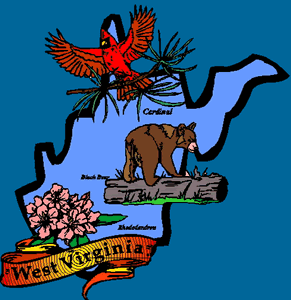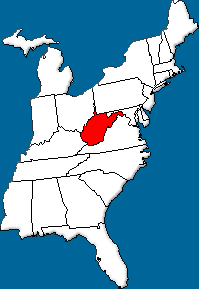 History:
In examining the history of West Virginia, remember that the state shares its history from 1609 until 1863 with Virginia, of which it was a part until Virginia seceded from the Union in 1861. At that time, the delegates of the 40 western counties who opposed secession formed their own government, which was granted statehood as part of the Union in 1863.
The first permanent European settlement in what would one day become the state of West Virginia was established by Colonel Morgan on Mill Creek, in present-day Berkeley County, in 1731.
Early defeats in the French and Indian War led Virginia Governor Robert Dinwiddie to construct forts to protect settlers in the area. From 1756 to 1758, Native Americans attacked Fort Evans in present-day Berkeley County and Forts Seybert and Upper Tract in present-day Pendleton County, as well as sites throughout the Monongahela, New River, and Greenbrier valleys. In 1763 the Treaty of Paris ended the French and Indian War and gave England title to virtually all territory east of the Mississippi River including the area that would become West Virginia.
With the French eliminated, Native Americans were left alone in their fight against British colonial advances. In the summer of 1763 Shawnee chief Keigh-tugh-qua, or Cornstalk, led attacks on western Virginia settlements in present-day Greenbrier County. By the end of July, Indians had captured all British forts west of the Alleghenies except Detroit, Fort Pitt, and Fort Niagara. On August 6, British forces under Colonel Henry Bouquet retaliated, destroying Delaware and Shawnee forces at Bushy Run in western Pennsylvania, which ended the hostilities. Fearing more tension between Native Americans and settlers, England's King George III issued the Proclamation of 1763, prohibiting settlement west of the Allegheny Mountains. However, many land speculators (including future US President George Washington) violated the proclamation by claiming vast acreage in western Virginia. However, the next five years were relatively peaceful on the frontier. In 1768, the Six Nations and Cherokee signed treaties relinquishing their claims on the territory between the Ohio River and the Alleghenies to the British. With the frontier again open, settlers flooded into western Virginia.
The Shawnee had never given up their claims to western Virginia and saw this new wave of settlement as acts of aggression. Hostilities reached a climax in 1773 when land speculator Michael Cresap led a group of volunteers from Fort Fincastle (later renamed Fort Henry) at present-day Wheeling and raided Shawnee towns in what became known as Cresap's War. The subsequent conflicts between European settlers and land speculators and the Shawnee tribes resulted in significant losses on both sides. The Shawnee retreated to settlements in present-day Ohio, and eventually, the Delaware, Shawnee and Mingo tribes gave up all claims to lands south of the Ohio River.
At the same time, tension was rising between American colonists and the British. As the Revolutionary War began, most Native Americans remained neutral. In return for their neutrality, they expected that the Ohio River would remain a boundary between their own lands and land open for settlement. However, settlers on the Colonial side continued to come into Indian land, and many tribes entered the war on the side of the British.
The bloodiest Revolutionary War battle in western Virginia began on September 10, 1782. Wyandot, Delaware, and British forces attacked Fort Henry. The most dramatic story associated with this siege of Fort Henry is the daring run of Elizabeth Zane, who allegedly carried gunpowder to the fort amidst heavy gunfire. The settlers held the fort and, after three days, the Indians and their British allies gave up. Soon thereafter, the British ordered a halt to all attacks on the frontier, and after the Revolutionary War officially ended in 1783, settlers again poured into western Virginia.
By 1861, the Civil War had begun as southern states seceded from the Union to join the Confederate States of America. Virginia was one of those states. However, the Appalachian Mountains divided the state both geographically and in opinion. The western part of the state was poor, with residents barely able to support themselves through small farms. Religiously, the residents of the western counties were also different from the dominant Episcopal faith of the prosperous farmers in the east. Finally, the residents were divided on the issue of slavery, with residents to the west opposing it. One of the most significant examples of this was the rebellion led by John Brown in Harper's Ferry (in the western part of the state) in support of freeing the slaves. Residents of the western counties wanted to form a state separate from Virginia. However, in order to do this, they needed approval from Virginia, and Virginia was not in favor of giving away its own territory.
The western residents discovered a loophole and used it to their advantage. Because the state of Virginia had illegally seceded from the United States, western residents were permitted to establish a new Virginia government which would be part of the Union. So, in 1861, a "Restored Government of Virginia" was formed with approval from the United States. This group then voted to approve the formation of the new state of West Virginia which was officially brought into the Union in 1863.
During the late 1800s, railroads expanded throughout the state. With new advanced technology, lumber and coal production increased dramatically, and by the early 1900s, much of West Virginia's population worked in coal mines. The work was dangerous, and accidents killed hundreds of miners. In 1902, the United Mine Workers labor union organized several miners and demanded safer working conditions, shorter work hours, and better wages. Deadly fights often broke out between mine owners and union members, which ended for a short time under military law. In 1933, the National Recovery Administration was established. It protected union members and helped to bring about the needed changes within the mines. In the late twentieth century, West Virginia has suffered from the loss of jobs through the collapse of several of its major industries, including coal and steel, but the state's abundant natural resources has meant an increase in tourism. |









